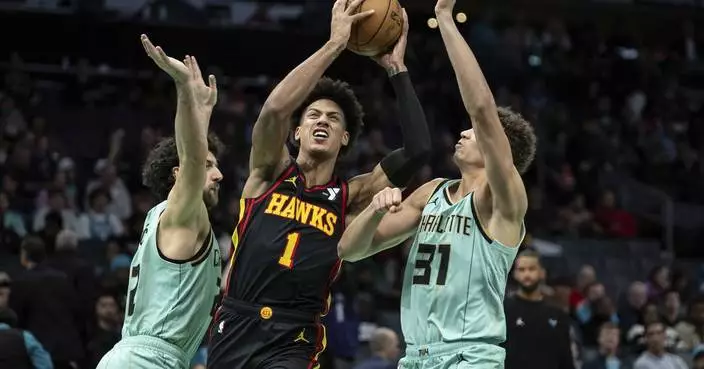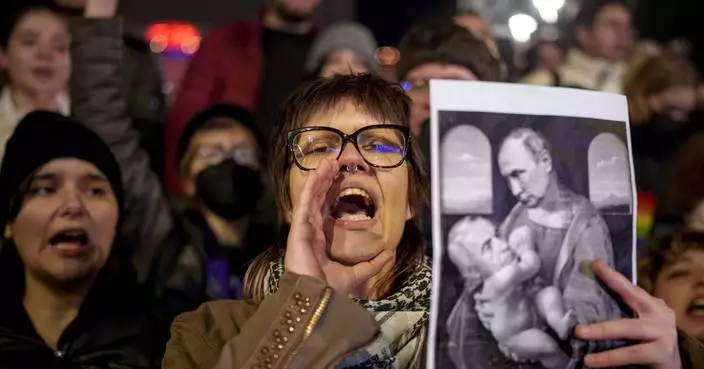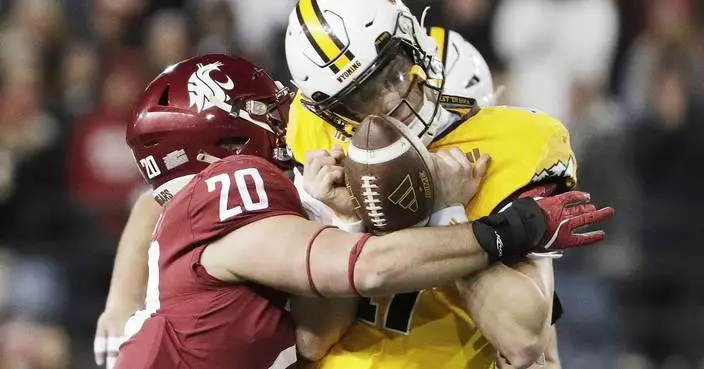College football was dominated by flags on Saturday. Not the ones thrown by officials — the ones planted by players in the middle of the field.
Michigan, North Carolina State and Florida celebrated road wins by displaying flags on the logos in the middle of their rivals' stadiums. Arizona State put its own twist on the day with a trident.
The results were, well, predictable.
Michigan scuffled with Ohio State after a group of Wolverines attempted to plant their flag in the middle of Ohio Stadium in Columbus following a 13-10 victory. There was a similar scene in Chapel Hill, North Carolina, after at least one N.C. State player tried to plant a Wolfpack flag on UNC’s field following a 35-30 win. And another skirmish in Tallahassee, Florida, after Gators edge rusher George Gumbs Jr. planted a flag on Florida State's logo after a 31-11 win.
“Obviously what happened there at the end of the game is not who we want to be as a program,” Florida coach Billy Napier said. “It’s embarrassing to me and it’s a distraction from a really well-played football game. I want to apologize on behalf of the entire organization just in terms of how we represented the university there. We shouldn’t have done that. We won’t do that moving forward. And there will be consequences for all involved.”
Arizona State defensive lineman Jacob Rich Kongaika tried to plant a trident in the middle of Arizona's logo after a 49-7 win over the Wildcats. Kongaika, an Arizona transfer, then held on as Arizona wide receiver Montana Lemonious-Craig tried to take the trident away, and the duo was surrounded by players from each school.
There was another skirmish after Missouri's dramatic 28-21 win over visiting Arkansas, but it didn't look as if there were any props involved.
Police in Ohio used pepper spray to break up the players, who threw punches and shoves in the melee that overshadowed the Wolverines' victory. One officer suffered unspecified injuries and was taken to a hospital, a police union official said.
Ohio State coach Ryan Day said he understood his players’ actions.
“There are some prideful guys on our team who weren’t going to sit back and let that happen,” Day said.
Michigan running back Kalel Mullings said he didn’t like how the Buckeyes players involved themselves in the Wolverines’ postgame celebration, calling it “classless.”
Get poll alerts and updates on the AP Top 25 throughout the season. Sign up here. AP college football: https://apnews.com/hub/ap-top-25-college-football-poll and https://apnews.com/hub/college-football

Florida State and Florida players scuffle at midfield after an NCAA college football game Saturday, Nov. 30, 2024, in Tallahassee, Fla. (AP Photo/Colin Hackley)

Florida State and Florida players scuffle at midfield after an NCAA college football game Saturday, Nov. 30, 2024, in Tallahassee, Fla. (AP Photo/Colin Hackley)
NEW YORK (AP) — Lou Carnesecca, the excitable St. John’s coach whose outlandish sweaters became an emblem of his team’s dazzling Final Four run in 1985, has died at 99, just a few weeks shy of what would have been his 100th birthday.
The university said it was notified by a family member that Carnesecca died in a hospital on Saturday surrounded by his family. St. John's said Carnesecca “endeared himself to generations of New Yorkers with his wit and warmth.”
Carnesecca was a treasured figure in New York sports in his day, affection for “Looie” never wavering in a city with little patience for its players, coaches, executives and owners.
He coached St. John’s for 24 seasons over two stretches -- making a postseason tournament each year -- and became the face of a university whose campus arena in Queens would eventually carry his name. A statue of him was unveiled before the 2021-22 season. When asked once in a question-and-answer sit-down with the school to describe St. John’s, Carnesecca said: “home.”
It was home where he coached St. John’s to 18 20-win seasons and 18 NCAA Tournament appearances. It was home where he finished with a 526-300 record and had 30-win seasons in 1985 and 1986. And it was home where St. John’s became part of the foundation of the Big East Conference.
He was the coach of the year three times in a league that began in 1979 and quickly asserted itself as one of the nation’s best. Among his players during those early Big East years were Chris Mullin, Mark Jackson and Walter Berry.
Carnesecca coached St. John’s to the NIT title in 1989, although by then the tournament had long been a poor cousin to the NCAAs. He entered the Basketball Hall of Fame in 1992, the year he retired.
“I never scored a basket,” he said at his induction, forgoing a sweater for a crisp suit. “The players did everything. Without players, you can’t have a game.”
He was an old-school coach, grounded in fundamentals. And through it all, Carnesecca was a swirling, kinetic presence on the sidelines, arms flailing, legs kicking, shirt tails flying, all 5-foot-6 of him curled in exasperation over a missed shot or agonizing call. But his antics never crossed the line into chair-throwing fury.
Carnesecca was simply consumed by his players, a love for a game in his marrow, a lifetime spent in schoolyards, beat-up gyms and big-time arenas. He loved the “smell of the sweat” and the “feel of rubber burning” when sneakers met a varnished floor.
He remained the consummate gentleman in a sport populated by outsized egos, fierce recruiting wars and a relentless pursuit of the next contract. Mike Tranghese, a former Big East commissioner, once called him “our soul and our conscience” and “one of the giants of the game.”
Carnesecca never took himself too famously. He always believed a rough loss should never get in the way of a glass of Chianti and fettuccini with a Bolognese sauce. He held clinics all over the world, making friends, offering toasts wherever he went. He was there with a kind word as well as a wisecrack in his breathy, raspy voice. His family tree may have gone back to Tuscany, but he could hold his own with the best of Borscht Belt comics.
“I don’t know if there’s anybody else in coaching like him,” longtime UConn coach Jim Calhoun once told the Hartford Courant. “Even if people hate the Big East nobody hates Looie. If you like basketball, you like Looie. If you like kids, you like Looie.”
Luigi P. Carnesecca was born on Jan. 5, 1925, the son of Italian immigrants. He grew up in Manhattan, in East Harlem, living above the grocery store and deli owned by his father. He took his heritage seriously, rooting for such New York Yankees as Tony Lazzeri and Joe DiMaggio.
After a stretch in the Coast Guard during World War II, he became the coach at his high school -- now the basketball power Archbishop Molloy. In 1958, he took an assistant’s job at St. John’s, his alma mater, where he had played baseball but not varsity basketball.
He worked for eight seasons under Joe Lapchick, the lessons about humility and hard work from the legendary coach lasting a lifetime. Carnesecca would later pass along to Mullin some advice he got from Lapchick: “A peacock today, a feather duster tomorrow.”
“I learned more when coach Lapchick cleared his throat than I could have at any clinic,” Carnesecca said.
He succeeded Lapchick in 1965, the 20-win seasons piling up quickly. But after five years, Carnesecca was not immune to the siren song of the pros. He coached the New York Nets of the American Basketball Association for three years, Rick Barry among his players.
Years later, during a 1982-83 season in which his St. John’s team would finish 28-5, Carnesecca reflected on the pressure of college coaching and his time in the ABA.
“I lost 50 games coaching professionally -- that was pressure,” he said. “I didn’t feel like getting out of bed. My mother could coach this team.”
His stay in the pros didn’t last long. Carnesecca knew that was not his natural habitat. He said he could give the same halftime speech only so many times. He returned to St. John’s in 1973.
Winning seasons followed in quick succession even though his city was no longer the recruiting magnet of generations past. Top high school players migrated to campuses with gleaming arenas and didn’t need the commercial pull of New York to burnish their brand.
When asked why he didn’t expand his base in his search for players and venture beyond his city’s five boroughs, Carnesecca knew he had plenty of talent in his neighborhood. He took a subway token -- now a relic from bygone generations -- out of his pocket.
“That’s my recruiting budget,” he said.
By the 1984-85 season, Carnesecca and St. John’s captivated New York, a throwback to a time when schools like City College and NYU mattered not only in New York but across college basketball. The Redmen -- their nickname years later changed to the Red Storm -- played tough, pulsating games at a packed Madison Square Garden against Syracuse teams coached by Jim Boeheim, Villanova teams coached by Rollie Massimino and Georgetown teams coached by John Thompson and led by Patrick Ewing.
It was then the saga of The Sweater took hold. Over the years, Carnesecca would recount his baffling entry into the world of fashion time and again like an embellished family tale.
Essentially, St. John’s was getting ready for a road trip to Pittsburgh in January and Carnesecca was under the weather. The building would be drafty, and his wife thought it would be good if he wore a sweater. He found one that had been given to him by an Italian basketball coach. It was a brown pullover with broad turquoise stripes. It never made it into the pages of GQ.
“It is ugly, isn’t it?” Carnesecca said.
No matter. Mullin hit a winning shot at the buzzer, and the coach had his lucky charm. He stuck with the sweater. Along the way, St. John’s ended Georgetown’s 29-game winning streak and soared to a No. 1 ranking.
But there were also two lopsided losses to Georgetown during the 16-2 run with the sweater. He put it away, his luck exhausted with the pullover. He then went with a tan, snowflake number for the NCAA Tournament. St. John’s defeated Southern, Arkansas and Kentucky before a victory over North Carolina State in the West Regional final sent Carnesecca to the Final Four.
“When I’m going to my grave,” he said, “this I’ll remember.”
St. John’s headed to Lexington, Kentucky, along with two Big East compatriots -- Georgetown and Villanova -- and Memphis. St. John’s stuck with Georgetown in the semifinals, down 32-28 at the half. But the Hoyas pulled away to win 77-59, holding Mullin to eight points.
“I think we tried everything,” Carnesecca said of Georgetown, which would go on to lose to Villanova in one the sport’s great finals.
After he retired, Carnesecca was succeeded by a parade of coaches at St. John’s, Mullin among them. Even into his 90s, some three decades out of coaching, Carnesecca would make his way to the Garden when the Red Storm were there. His gait may have been tentative but his mind and wit nimble, the crowd roaring when the jumbo screen panned in on him. The coach was at home.
“It’s going to be very difficult to put the ball down, but the time has come,” he said at his retirement when he was 67. “There are two reasons, really. I still have half of my marbles and I still have a wonderful taste in my mouth about basketball.”
The school said Carnesecca leaves behind his wife of 73 years, Mary, as well daughter Enes and son-in-law Gerard, as well as a granddaughter, a niece and nephew in addition to extended family.
Fred Lief, a retired Associated Press sports writer, was the principal writer of this obituary. Former AP Sports Writer Paul Montella contributed to this report.
Get poll alerts and updates on AP Top 25 basketball throughout the season. Sign up here. AP women’s college basketball: https://apnews.com/hub/ap-top-25-womens-college-basketball-poll and https://apnews.com/hub/womens-college-basketball

FILE - Former St. John's head coach Lou Carnesecca speaks to the media after Rick Pitino was introduced as St. John's new basketball coach during an NCAA college basketball news conference at Madison Square Garden in New York, on March 21, 2023. (AP Photo/Corey Sipkin, File)

FILE - Former St. John's men's basketball coach Lou Carnesecca smiles during a news conference to announce the hiring of his former player and retired NBA basketball All-Star Chris Mullin, on April 1, 2015, in New York. (AP Photo/John Minchillo, File)













